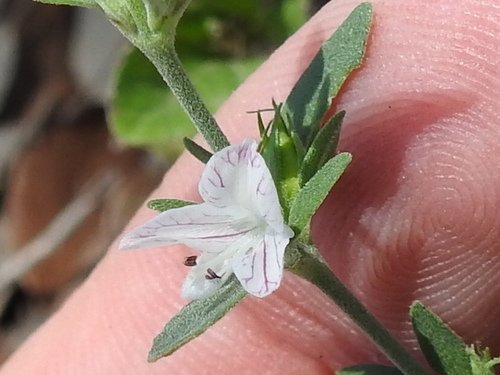The Genus Carlowrightia
Family: Acanthaceae
These are mainly small shrubs bearing inflorescences of lily-like flowers. They are native to the Americas, ranging from the southwestern United States through Mexico and Central America, and in Ecuador. Many species are native to western North America. The genus was named for the American botanist Charles Wright. There are 27 accepted species. There are three species you might find in our region.
Photo of Carlowrightia texana by Sam Kieschnick, iNaturalist
Arizona Wrightwort
Carlowrightia arizonica
These are small perennials that rarely get over a foot, though sometimes they can scramble up inside another shrub to 3’ tall. Flowers are almost pea-like and occur in spring. The stems are almost succulent and on trails it is difficult to find a plant that isn’t browsed by wildlife. Many of the stems of the plant are green and the plant can often be leafless. In the field, this plant can often be confused with the related Justicia longii, which has more tubular flowers that are typical of this plant family.
Plant in full to part sun, with moderate water (good drainage is key). Plants are often found growing between rocks in nature. Frost tolerance isn’t known. Plants turn purple with cold weather and are probably hardy at least into the low 20s °F. In nature they occur up to 4,000’ though usually in protected rocky foothill locations.
Carlowrightia arizonica on iNaturalist
Photo by Sue Carnahan, SEINET
The flowers are especially nectar-rich for bees, butterflies, and other pollinators. Larval food plant for the Texas crescent butterfly (Anthanassa texana).
The Mayo used it in a tea taken for fevers.
Carlowrightia is named for American botanist Charles (Carlos) Wright (1811-1885), and arizonica refers to Arizona.
Found on dry rocky slopes from 2,500-4,000 ft. from the southwestern United States to northern Costa Rica.
Texas Wrightwort
Carlowrightia texana
Small plant to 8” tall, more leafy and pubescent (fuzzy) than the Arizona wrightwort.
Part sun, good drainage, moderate water. Hardiness unknown but probably hardy to at least the low teens °F.
Larval food plant for the Texas crescent butterfly (Anthanassa texana).
This species grows on rocky slopes and flats, often in disturbed soil. It is also found on the Edwards Plateau, the Rio Grande Plains and into New Mexico and Mexico.
Carlowrightia texana on SEINET
Photo by Carlos G Velazco-Macias, iNaturalist
Heath Wrightwort
Carlowrightia linearifolius
Probably the most substantial of the wrightworts, this is an herbaceous perennial growing up to 4’ tall and wide, rarely just a tad bigger. Purple flowers from spring into fall. Full to part sun, moderate water with good drainage, probably hardy to at least low 20s °F, perhaps even lower.
Larval food plant for the Texas crescent butterfly (Anthanassa texana).
The species name, linearifolius, refers to the slender leaves of this species.
Found in sandy-gravelly soils and among rocks and boulders on slopes, in arroyos and canyons, from 2,500-5,000 ft. southeast Arizona, southern New Mexico, and western Texas, and a bit in Chihuahua, Coahuila, and probably in Sonora too, though not recorded there yet. A few disjunct populations in Baja California.
Photo by rloera on iNaturalist
Carlowrightia linearifolia on SEINET




